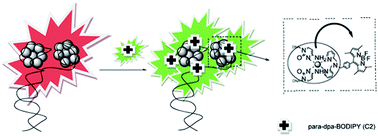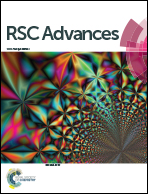A DNA–Ag cluster as a sensor for BODIPY isomers and HepG-2 cells†
Abstract
The isomers of BODIPY exhibit different cytotoxicities in the cancer treatment process. A type of homoduplex structure, DNA–Ag nanoclusters (DNA–AgNCs), was prepared to distinguish a para-substitued-BODIPY (C2) from a meta-substitued-BODIPY (C1) by their fluorescent quenching constants. Intercalation of C2 to the homoduplex and effective energy transfer in the conjugated system, formed by the coordination of the Ag in DNA–AgNCs with the N atoms of the two pyridines, were found to be two key factors for DNA–AgNCs to recognize the special isomers of BODIPY and therefore enhance the emission of C2. The high sensitivity of DNA–AgNCs to total protein from HepG-2 cells makes it a potential sensor for cancer cells with high expression of hypoxia-inducible factor.


 Please wait while we load your content...
Please wait while we load your content...